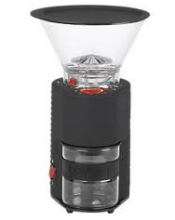The main catch with burr grinders, though, is that they’re considerably more expensive than blade grinders. In my opinion, if you’re investing upward of $100 in a machine to grind your morning cup of coffee, it had better be well-made and work without problems.
Retailing at just under $80 (on Amazon.com), the Bodum Bistro burr grinder is relatively reasonably-priced—but does its low price reflect low quality? In a word, no, but like most home appliances it has its pros and cons.
For starters, the controls are few, simple, and straightforward—the top of the machine has a control for the coarseness of the grain, going all the way from a French press (on the far right) to an espresso wand (on the far left). These settings are succinctly represented by pictures. On the top there’s also a time knob, selectable between 5 and 20 seconds, as well as a button that starts the grinder. On the side of the machine there’s a power switch that must be toggled on before the unit can operate. Though there are few controls and they seem intuitive, it’s easy to run into issues on first use. Sure, we all know how long 5 seconds lasts, but how much ground coffee will that amount of time produce? The manual doesn’t say, so you have to figure it out by trial and error, which leads me to my next point. The grind function of the machine can only be used once every five minutes, to prevent the machine overheating. Unless you’re already familiar with similar grinders, you can expect your first experiments to either produce a few potentially sub-optimal cups of coffee or take up a good chunk of your morning waiting for the machine to cool off!
As far as the bean storage receptacle and ground coffee container are concerned, I have few complaints. The receptacle is removable, so you can empty out the beans you don’t use. The ground coffee container, as the product description boasts, is made of glass, which prevents static that can cause the grounds to cling to the container. However, the inside of the machine tends to hang onto a few of the grounds. It’s helpful to tap the unit a bit before removing the grounds container—otherwise you end up with grounds on your countertop. Wasted coffee and cleanup are definitely cons.
Somewhat less importantly, this grinder’s appearance is fairly attractive, although the cone-shaped bean receptacle might not be to everyone’s taste. I have the black model—I’m really not sure the green, orange, or even red models still qualify as “fairly attractive,” but it’s good to know there are classic color options available for those of us who are less adventurous.
All in all, this burr grinder is a pretty safe bet; though getting the hang of its operation is something that takes a little hands-on experience and (somewhat frustratingly) cannot be done by simply reading the instructions, once you get a grasp of the basics it is easy to operate, clean, and the price doesn’t hurt!
